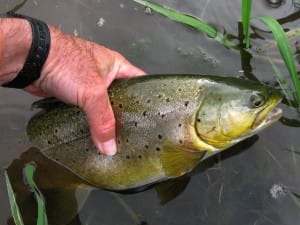Water levels are very high and fast flowing, with the river just breaking over its banks in some places. Wellingtons are essential. The high water has shifted a lot of silt & the gravels are clean which should make sight fishing much improved this year. High water has also helped much of the invertebrate life & the monthly 3 minutes kick sampling shows there to be abundant Gammarus (Shrimps) & huge numbers of Cased Caddis larvae (mainly tiny Agapetus), plus decent numbers of Baetis (Olive) nymphs & already a few Blue-winged Olive nymphs.
Dry fly activity is usually slow to start on Driffield Beck with only sparse hatches of Large Dark Olives & a few Midges emerging so heavily weighted Shrimp & Nymph patterns are likely to bring the best chance of results with the trout. However, it is worth having a few size 16 Shuttlecocks, Adams, Kite’s Imperials or similar dry Olive imitations, plus some size 20 or smaller Midges (IOBO Humpies or Griffiths Gnats). It is even worth trying a Daddy or a size 14 or 12 Caddis pattern (Elk Hair Caddis or F Fly) as isolated Craneflies & adult Caddis are about throughout the trout season. By the end of April & into May there will hopefully be good falls of Black Gnats & Hawthorn Flies. Once we are into May Agapetus Caddis pupae will be emerging & then the fish can become totally focused on them to the exclusion of more obvious food such as the Black Gnats, Hawthorn Flies & Olive Duns (see previous reports for information on Agapetus & I will give reminders in my next report).
Ideally, whether nymphing or fishing dry flies, fish to sighted fish that are seen to be actively feeding. Blind search-fishing the water tends to be counter-productive, scaring more fish than it is worth. It is also worth remembering that, since chalk streams are so rich in food organisms, the fish may only be actively feeding for a short period of the day, so it is essential to make the most of any window of opportunity: wear camouflaged or drab clothing; move slowly; keep low; avoid as far as possible false casting; use polaroid glasses so that hopefully you will see the fish before they see you.
Ensure that you have a long handled landing net big enough to accommodate trout of 24” plus in length, forceps or a decent unhooking tool and a long rod (9‘ or longer) to reach over the bankside vegetation that is left to give shelter to the insects and cover for the anglers. Please handle fish that are to be returned carefully, with wetted hands, ensuring that they are returned to the water as soon as possible (10 seconds or less). If the fish has fought hard give it some recovery time under water in the net before unhooking & taking any photographs. If taking pictures have the camera set up & ready before removing the fish from the water. If possible when returning the fish hold it gently facing upstream until it is strong enough to kick away. Badly handled fish don’t get a chance to grow into big fish!
Finally, avoid targeting the grayling (clearly distinguished by their forked tails) as they will be spawning or will be weak after spawning & so are not in season till June 16th. Our grayling populations are very low due to cormorant predation & they need all the protection they can get. Nevertheless you may well see some huge grayling, well over the coveted 3lb mark.
Tight lines, Dave Southall

Hi looking for two days back to back 27-29th June for 3-4 rods and suitable self catering I’ve been a few times before can you let me no availability over those three days.
Regards
Bob glynn